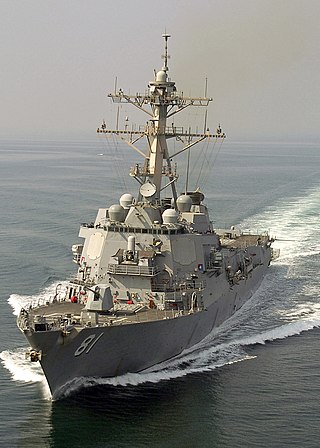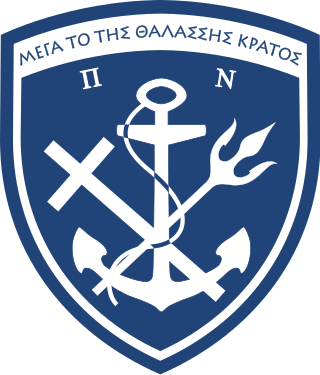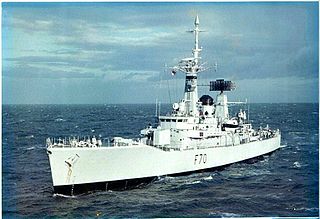Related Research Articles

A carrier battle group (CVBG) is a naval fleet consisting of an aircraft carrier capital ship and its large number of escorts, together defining the group. The CV in CVBG is the United States Navy hull classification code for an aircraft carrier.

In naval terminology, a destroyer is a fast, manoeuvrable, long-endurance warship intended to escort larger vessels in a fleet, convoy, or battle group and defend them against powerful short-range attackers. They were originally developed in 1885 by Fernando Villaamil for the Spanish Navy as a defense against torpedo boats, and by the time of the Russo-Japanese War in 1904, these "torpedo boat destroyers" (TBDs) were "large, swift, and powerfully armed torpedo boats designed to destroy other torpedo boats". Although the term "destroyer" had been used interchangeably with "TBD" and "torpedo boat destroyer" by navies since 1892, the term "torpedo boat destroyer" had been generally shortened to simply "destroyer" by nearly all navies by the First World War.

A frigate is a type of warship. In different eras, the roles and capabilities of ships classified as frigates have varied somewhat.

The Royal Netherlands Navy is the naval force of the Kingdom of the Netherlands.

The Type 42 or Sheffield class, was a class of fourteen guided-missile destroyers that served in the Royal Navy. A further two ships of this class were built for and served with the Argentine Navy.

The Exocet is a French-built anti-ship missile whose various versions can be launched from surface vessels, submarines, helicopters and fixed-wing aircraft.

The Hellenic Navy is the naval force of Greece, part of the Hellenic Armed Forces. The modern Greek navy historically hails from the naval forces of various Aegean Islands, which fought in the Greek War of Independence. During the periods of monarchy it was known as the Royal Hellenic Navy.

The Type 22 frigate also known as the Broadsword class was a class of frigates built for the British Royal Navy. Fourteen were built in total, with production divided into three batches.

The Type 45 destroyer, also known as the D or Daring class, is a class of six guided-missile destroyers built for the United Kingdom's Royal Navy in the early 21st century. The class is primarily designed for anti-aircraft and anti-missile warfare and is built around the PAAMS air-defence system using the SAMPSON Active electronically scanned array (AESA) and the S1850M long-range radars. The first three destroyers were assembled by BAE Systems Surface Fleet Solutions from partially prefabricated "blocks" built at different shipyards; the remaining three were built by BAE Systems Maritime – Naval Ships. The first ship in the Daring class, HMS Daring, was launched on 1 February 2006 and commissioned on 23 July 2009.

The Type 21 frigate, or Amazon-class frigate, was a British Royal Navy general-purpose escort that was designed in the late 1960s, built in the 1970s and served throughout the 1980s into the 1990s.

The Leander-class, or Type 12I (Improved) frigates, comprising twenty-six vessels, was among the most numerous and long-lived classes of frigate in the Royal Navy's modern history. The class was built in three batches between 1959 and 1973. It had an unusually high public profile, due to the popular BBC television drama series Warship. The Leander silhouette became synonymous with the Royal Navy through the 1960s until the 1980s.

Destroyer escort (DE) was the United States Navy mid-20th-century classification for a 20-knot warship designed with the endurance necessary to escort mid-ocean convoys of merchant marine ships.

The Principal Anti-Air Missile System (PAAMS) is a joint programme developed by France, Italy, and the United Kingdom for an integrated anti-aircraft warfare system. The prime contractor is EUROPAAMS, a joint venture between Eurosam (66%) and UKAMS (33%). In the United Kingdom, PAAMS has been given the designation Sea Viper.

The Horizon class (French: Classe Horizon; Italian: Classe Orizzonte) is a class of air-defence destroyers in service with the French and Italian navies. They are designated as destroyers by the Italians and using NATO classification but are referred to as "frigates" by the French. The programme started as the Common New Generation Frigate (CNGF), a three-nation collaboration between France, the United Kingdom, and Italy to develop a new generation of air-defence warships. Differing national requirements, workshare disagreements and delays led to the UK withdrawing from the project in 1999 to develop the Type 45 destroyer.

European multilateral defence procurement refers to the collective armaments purchasing policies of European nations.

Naval tactics and doctrine is the collective name for methods of engaging and defeating an enemy ship or fleet in battle at sea during naval warfare, the naval equivalent of military tactics on land.

The four De Zeven Provinciën-class frigates are air-defence and command frigates in service with the Royal Netherlands Navy. This class of ships is also known as "LCF". The ships are similar to the German Sachsen-class frigates in role and mission.

The Tariq-class destroyers are a class of guided missile destroyers of the Pakistan Navy. They were acquired from the British Royal Navy in 1993–94. The Tariqs were formerly commissioned in the Royal Navy's Surface Fleet as Type 21 (Amazon-class) frigates, a general purpose frigate in the Royal Navy.

The Otomat is an anti-ship and coastal defence missile developed by the Italian company Oto Melara jointly with Matra and now made by MBDA. The name comes, for the first versions, from the name of the two builders and, for the later versions, Teseo, from the Italian word for Theseus. The MILAS variant is an anti-submarine missile. In its latest version Mk/2E purchased by the Italian Navy is a medium range anti-ship missile and a ground attack missile.

Operation Atalanta, formally European Union Naval ForceSomalia, is a current counter-piracy military operation at sea off the Horn of Africa and in the Western Indian Ocean, that is the first naval operation conducted by the European Union (EU). The operational headquarters is currently located at the Spanish Operation Headquarters (ESOHQ) at Naval Station Rota in Spain, having moved from London as a result of the British withdrawal from the EU.